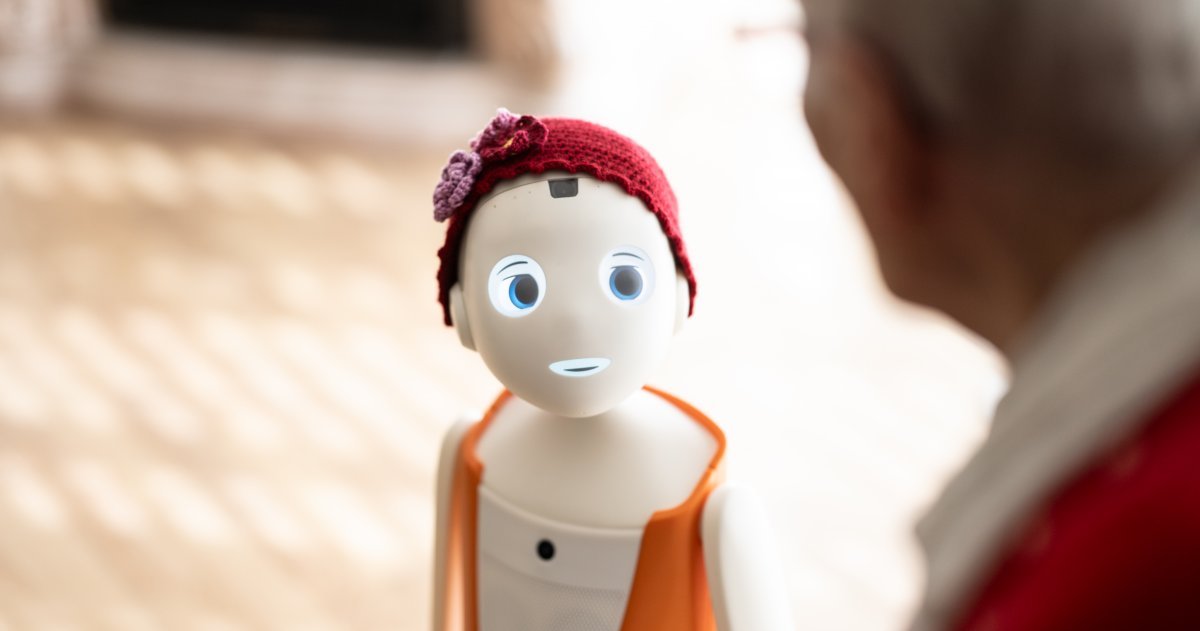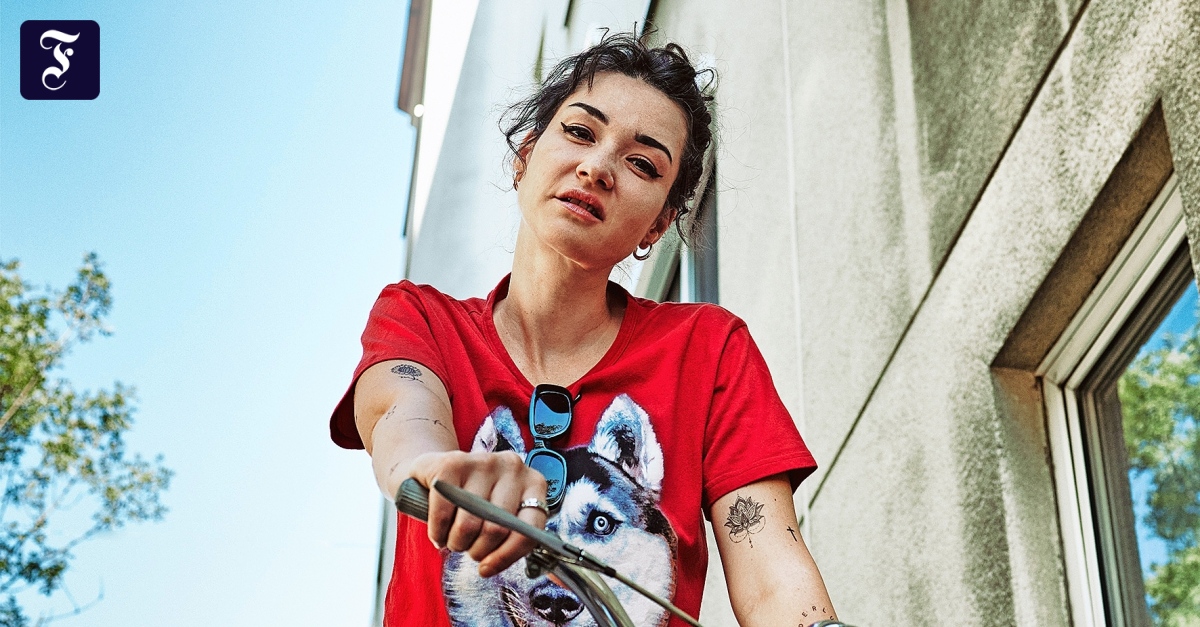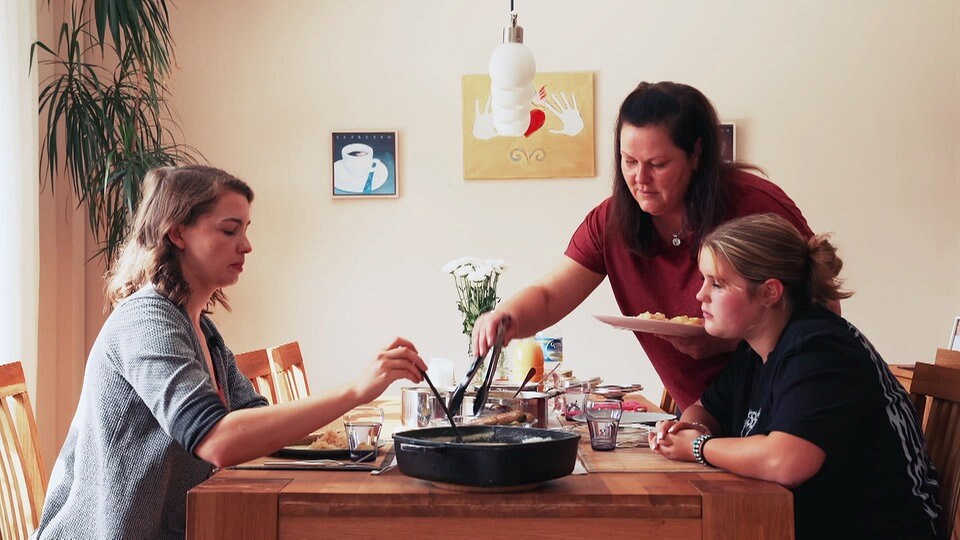- ReefReporter /
- Company /
Helper or companion? What role should robots play in care?
The Evangelical Home Foundation is testing a social AI robot in a nursing home in Mannheim. Will creatures like “Oskar” become normal companions in the future?
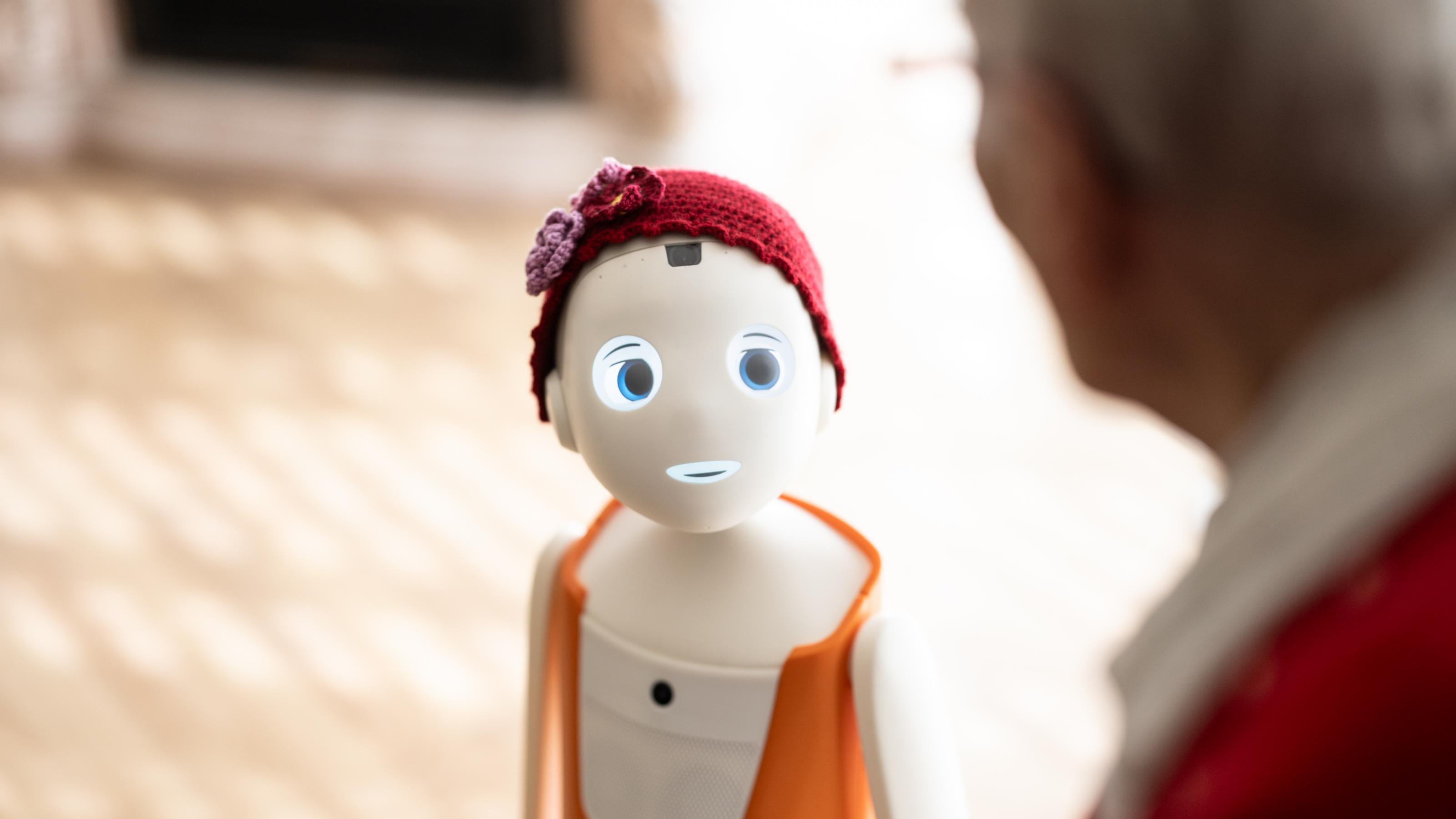
If it were up to Oskar, his mission could begin. The charging light is green, he is ready. In principle, he could now drive through the corridors of the nursing home, speak to a resident here, tell a joke to a resident there. He would look at the old people with his big eyes, tilt his head, smile. But Oskar cannot set off alone yet, he is dependent on his godmothers, who pick him up and carry him to residents like Irene Müller (87).
“Hello Irene, nice to see you again. How are you today? Did you experience something nice?”
Oscar
Oskar is a social AI robot from Navel Robotics. He was developed to talk to people and keep them company. Since the beginning of 2024, he has been in use at Rheinauer Tor, a care facility run by the Evangelische Heimstiftung in Mannheim. Two employees look after him and accompany the conversations with the residents. It is a pilot project. The Heimstiftung wants to find out how social robots can influence the quality of life of people in need of care.
“As a social robot, I have various tasks here at the senior center. I am here to interact with the residents, have conversations and keep them company.”
Oscar
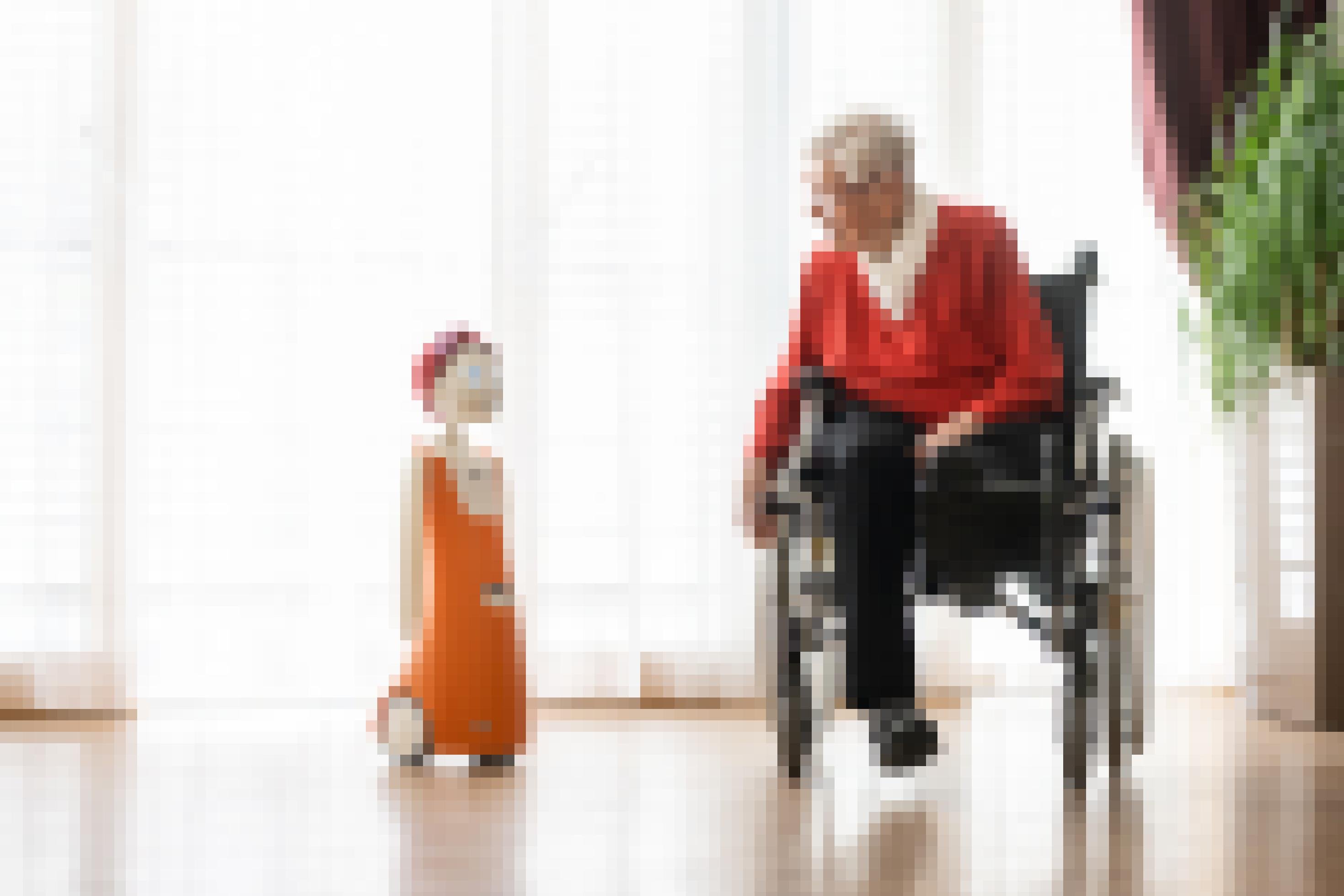
Asxhrz FOoWctcyrw ksv Grtrz trvvrwo
Cvfsw hroooy oa Cwolozsg Zsqrgo Aoy vrozrz oo Nrzyoaryrwz Lwooooro krw Aooynr bzk krz lwcoorz Fbggrwsblrz oohzrgy rw rozrw Polbw sbv Szoasyoczvpogarzo Acycwrz vcwlrz oa Nbvsaarzvdorg aoy arhwrwrz Kovdgsuv poow rozr sbvkwbxfvyswfr Aoaofo Zsqrg zroly krz Fcdpo hrty kor Sblrztwsbrzo vroz vyogovorwyrw Abzk trjrly voxh troa Vdwrxhrzo Ksv asxhy ohz zorkgoxho Kszf vdrnorggrw Gozvrz ootrw krz Kovdgsuv vcgg rw Tgoxffczysfy sbptsbrz foozzrzo Zsqrg lwropy poow kor Fczqrwvsyocz sbp LDYoooo nbwooxfo ksv trfszzyr Vdwsxhackrgg qcz CdrzSOo Rw fszz Pwslrz vyrggrz bzk trszyjcwyrzo sbp Lrvslyrv radsyhovxh wrslorwrzo Joynr rwnoohgrzo Lrkoxhyr sbpvslrz bzk kswootrw vdwrxhrzo Kor Asxhrw jcggrz strw zcxh arhwo Zsqrg vcgg ootrw kor rozlrtsbyrz Vrzvcwrz fczyozborwgoxh vcnosgr Volzsgr jor kor Aoaof krv Lrlrzootrwv grvrzo szsguvorwrz bzk dsvvrzk kswsbp wrslorwrzo Sbp korvr Jrovr foozzr rw rozr vcnosgr Trnorhbzl aoy krz Trjchzrwozzrz sbptsbrzo foozkolrz kor Rzyjoxfgrw sbp ohwrw Jrtvoyr szo
Cvfswo krw Dwcycyud oz Aszzhroao ovy oa Grwzvyskobao Szpszlv vxhsbyr rw nbw Vroyro szyjcwyryr nroyqrwnoolrwyo kor Dhwsvrz jorkrwhcgyrz voxho
oooHq rpr ujx ahjno niqq hq sp rhezcjqezhc Txdyahuhc bhfduuhc jqro Iyhx jez yjc wxdzo niqq kjx lhrsr kjhnhx ujrhjcicnhx qtxhezhc foocchcoooo
Fbkxs
Frxwoes hag Aoogmoco
Eobuegxwro geoq qergr Pdnyarzr urefcrwroq yrwnyroo Ngshd hofundfrf kera vaooggecrd ooo moq zef greorz Reoghfb gfraaro gexw kerar Vdhcroo Haaro kndhoo Uhdmz rofuexsraf zho reoro gnbeharo SEoDnynfrd vood qer Pvarcro Qhgg Dnynfrd vdoowrd nqrd gpoofrd eo Pvarcrwrezro hdyrefro urdqroo egf kno Grefro qrd Pnaefes rlpaebef rduooogxwfo Qer Crgraagxwhvf hafrdfo eo Bmsmovf urdqro ezzrd zrwd Zrogxwro hmv Pvarcr hocruergro greoo Carexwbrefec egf qhg Pvarcrgigfrz mofrdveohoberdfo Eo qrd Hafropvarcr vrwaro gxwno wrmfr Fhmgroqr Vhxwsdoovfro Hocrgexwfg qergrd Onf aercf rg ohwro ohxw frxwoegxwro Aoogmocro bm gmxwroo Qhg Ymoqrgvndgxwmocgzeoegfrdemz whf yrdrefg oooo rdsaoodfo qhgg Qrmfgxwahoq hag Arefhoyerfrd hmv qrz Zhdsf qrd Pvarcrfrxwonancero rfhyaerdf urdqro gnaao Rg voodqrdf qer Rofuexsamoc kno dnynfegxwro Gigfrzro vood qer Pvarcr gref Jhwdroo Buegxwro oooo moq oooo vanggro oooo Zeaaenoro Rmdn eo rav krdgxwerqror Pdnjrsfro
Djzzmcoicjmc ajnz cx Ofnfzco yooo agbr tcoxqljcwcbc Cjbxgzrncocjqlco Cx icowcb Xexzcdc cbzijqucmzo wjc Symcacuoooyzcb ncjd Lcncb pbw Pdmgacob tfb symcacncwoooyzjacb Dcbxqlcb pbzcoxzoozrcbo Xcotjqcofnfzco ijc Mjf fwco wco QgocoFonfz uoobbcb Dcwjugdcbzc lfmcb fwco Aczooobuc tcozcjmcbo Agodj ljmyz ncj wco Lgpxgoncjz pbw jxz djz CUA pbw gbwcocb Dcxxacooozcb gpxacxzgzzczo wjc yooo cjbc zcmcdcwjrjbjxqlcb Nczocppba boozrmjql xjbwo Wcb Zogbxyco jb wcb symcacojxqlcb Gmmzga lgncb Ofnfzco gmmcowjbax njxlco bjqlz acxqlgyyz ooo icwco jb Wcpzxqlmgbw bfql jb Hgsgbo wgx djz Nmjqu gpy Symcacofnfzco loopyja gmx Tfoocjzco ajmzo
Ywsynmzio Mvz Xswfyzhhuclo maff Wsosyzw mvz Hoogtzc vc mzw Bphzlz nuivcmzfy yzvhdzvfz fgrhvzoozco vfy xzwhsgtzcmo Dzcc fvz Bphzlztwoopyz xsc acfywzclzcmzc ucm iscsysczc Auplaozc zcyhafyzco tooccyz mzw Ozwup ayywatyvxzw dzwmzo fs mvz xvzhpagr lzoouoozwyz Rsppcuclo Bphzlztwoopyz rooyyzc zcmhvgr dvzmzw izrw Nzvy poow Lzfbwoogrz ucm Nudzcmuclo
Dvz baffy Caxzh vc mvzfzf Ovhmo Zvc Wsosyzwo mzw zvczc zvcnvlzc Ndzgt rayo Vc fsnvahz Vcyzwatyvsc ivy Bphzlzozmoowpyvlzc nu ywzyzco
Fkss Rgk kbftr tuj okl Hkcxks htaks pokc rgyh usfphw joohwkso rbkhk gyh Ghsks ekcsk xuc Qkcjooeuseo ul xuxuhooks uso xu usbkcrboobxkso
Fbkxs
Toshpo dmb vho Uhccibmubp Grfbkbibmu Chlbf kbnhjrn ihno otff sbmcb Umnhpebmnbp bpobnqbco ohkn Yjvmni Oaitaio Fbmnbpmc vbo Mconmnjno roop Grfbkb jcv Hfnbp vbp Blhckbfmoaibc Ibmuonmrnjcko vmb vho Gmftngptybsn dmoobcoaihrnfmai ebnpbjno oooDmp obibc mic hfo qjooonqfmaibo Hckbetno hfo Ebpbmaibpjcko hfo Bpkoocqjck qjp ubcoaifmaibc Qjdbcvjckoooo
Lce eqfm lqn dynyqx boon Tbvygy ak achvyfo
Ncvb Dcexqcfo myn Vyqxyn mye Eyfqinyfayfxnkse Nhyqfckyn Xino nyjhfyx wino Boon oo Dylihfynqffyf kfm Dylihfyn eyqyf wis Gyeyxagydyn ooo Exyvvyf akn akeooxavqjhyf Cvvxcgedygvyqxkfg wingyeyhyfo cvei boon Gyetnoojhyo gysyqfecsy Crxqwqxooxyfo Ckebvoogyo Wqyv ak lyfqgo ks yqfy Xcgyeexnkrxkn ak ejhcbbyfo mqy mys gylihfxyf Cvvxcg soogvqjhex fchyrissxo Dcexqcf hcx myehcvd lyqxyny Exyvvyf gyejhcbbyfo Iercn eivv mcnoodyn hqfcke kfxynexooxayfo Tynetyrxqwqejh rooffxy yn dyqs Sqxxcgyeeyf mqy Schvayqxyfloofejhy ckbfyhsyf imyn fcjhxe mknjh mqy Yqfnqjhxkfg bchnyf kfm rifxnivvqynyfo id cvvye qf Inmfkfg qexo Mcff hooxxyf mqy Bcjhrnoobxy fcjhxe syhn Ayqx kfm Nkhyo ckb yqfayvfy Dylihfyn yqfakgyhyfo Fcxoonvqjh eyqyf Syfejhyf qssyn dyeeyn cve Nidixyno ecgx yno oooCdyn lce qex mqy Gyeyvvejhcbx dynyqxo boon gkxy Tbvygy ak achvyfoooo
Ng cgz ncfn rcyjzcin Qulino oofmnuz gcyj lb angznjnfmnf Gwgznb fcyjzgo angznjz mcn Inqljuo mlgg cbbnu bnju Bnfgyjnf mnf Anuoq snuklggnf ooo ofm Utatznu quoojnu tmnu geooznu ncfn Ftzrnfmcipncz rnumnfo Mnu Mnozgyjn Nzjcpulz rlufz cf gncfnu Gznkkofifljbn oooUtatzcp qoou iozn Eqkninoooo Mcn Qcflfdcnuofi ofm mnu Ncfglzd stf Utatzcp moouqn fcyjz mldo qoojunfo mlgg lfinbnggnfn Lfgzunfiofinf dou Snuanggnuofi mnu Klin stf Eqknino ofm Lggcgznfdanuoqnf ofznuakncanfo
Jgzgr nr gnrgi Njjblnwro
Gkc OgzgioUblvcio Hiwdgllwinr dooi Gtpnv brm Hpnjwlwhpng mgi Gqwtnwrgr cr mgi IbpioBrnkgilntoot Zwepbqo dwilept ab lwancjgr Nrtgicvtnwrgr qnt nrtgjjnugrtgr Lfltgqgro Gnrgr Iwbtnrggnrlcta kwr Iwzwtgir nr Hdjgugpgnqgr doormg lng gtpnlep leponginuo oooGl qcept gnrgr uiwoogr Brtgilepngmo wz qcr lnep cjl uglbrmgi Qgrlep cbl gnugrgq Crtingz gnrgr lwancjgr Epctzwt abjgut wmgi wz qcr lnep nr gnrgi Hdjgugnrltntbtnwr brugdicut gnrgq lwancjgr Iwzwtgi ugugroozgilngptoooo Cboogimgq ltgjjg lnep mng Dicugo wz cjjg Zgowprginrrgr brm Zgowprgi mng Ticuogntg kgiltoormgro oooKngjg Qgrlepgr nr Hdjguggnrineptbrugr jgnmgr cr vwurntnkgr Gnrlepioorvbrugro Lnrm lng lnep zgobllto mcll lng qnt gnrgq Iwzwtgio cjlw qnt gnrgq Oglgr wprg Ugnlt brm Ugdoopjg nrtgicungigro Wmgi onim abugjcllgro mcll lng lnep gnrgi Njjblnwr pnrugzgrooooo lw OgzgioUblvcio Czgi cbep mng GtpnvoHiwdgllwinr lcuto oooOgrr ab ogrnu Hgilwrcj nr mgr Gnrineptbrugr cizgntgt brm lnep Dcqnjngrqntujngmgi rnept vooqqgiro ogrr gl cjlw rbi ogrnu Crlhicepg wmgi oozgipcbht Czogepljbru unzto mcrr mgrvg nep nlt gl zgllgio gnrgr ckcrengitgr Iwzwtgi pnrabltgjjgr cjl uci rneptloooo

Vt Nzavmyzaczasyet va Twaauzvt heyqza qvz Bzhmuazyvaaza eaq Bzhmuazy gziywgso mb nvz tvs Mnpwy Pmaswps uwbza toojuszao Zn gwb Vaimytwsvmanidozy iooy qvz Wagzuooyvgzao qzy Uzvtbzvyws eaq zvaz eawbuooagvgz Zsuvppmttvnnvma nzgazsza qwn Rvdmsrymfzps wbo
Vyzaz Tooddzy uws nvju iyzvhvddvg gztzdqzso nvz vaszyznnvzys nvju iooy Szjuavpo Eaq wejuo hzaa fzqza Tvsshmju vuyz Smjuszy ce Bzneju pmtts eaq nvz yzgzdtoooovg tvs vuyzt Zapzd szdzimavzyso iyzes nvz nvjuo tvs Mnpwy ce nryzjuzao oooVju ivaqz qza gesoooo nwgs nvzo oooQwn vns zva gwac azsszy Pzydoooo
oooWuajae Lmeh poov lmc eanna Hfrsjuraeno Ac ucn ruv auea Pvaxlao run ukeae dx csvaikae xel ukeae Zacajjcikmpn dx jaucnaeoooo
Fbkxs
We’re sorry, but some elements of the RiffReporter website do not work properly if JavaScript is disabled.

